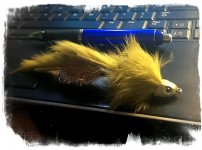gaeronf
Member
- Joined
- Mar 23, 2011
- Messages
- 483
Hey Everyone. We've had a lot of rain up near me and I think I am going to try to throw some streamers. I will be fishing a medium sized stream. I have been trying to read up on streamer fishing but I have no idea where to start. Could anyone shed some light on what water I should focus on? How should I fish the water? And what flies should I use? I will be using a 9' 6wt fly rod if that matters.




